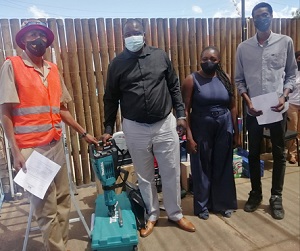
Income from Devil’s Claw sustains Bushman communities during drought

Di//xao Kaqece (right) from Makuri village in the Nyae Nyae Conservancy places raw Devil’s Claw slices on a suspended mat so that the slices can dry out in the sun. Once cured, these the dry slices are collected into bags for selling. Photograph by David Cole.
Devil’s Claw, a bush that grows in the central, eastern and northern parts of Namibia, may seem like an innocuous bush above the surface, but in the soil it grows large, elongated, potatoe-like tubers which are harvested by the San people of the Nyae Nyae and N#a Jaqna conservancies. The tubers are cleaned, sliced and sun-dried after which is sold as a medicinal substance.The reigning drought has had a detrimental impact on rural communities forcing them to look at alternative and innovative ways of generating income.The circumstances for San communities residing in the Nyae Nyae and N#a Jaqna conservancies are no different, however in this case many members have taken to harvesting and selling Devil’s Claw to earn a much needed supplementary cash income.Devil’s Claw is used all over the world as a non-prescription medicine and is taken to relieve arthritis, lower back, knee and hip pain. It is can also be used to treat a number of other conditions including osteoarthritis, rheumatoid arthritis, gout, bursitis, tendonitis, loss of appetite and digestive disorders. Because of its healing properties it is very sought after and Namibia is the largest supplier of Devil’s Claw in the world. However, it is listed as a protected plant and a permit is required for harvesting and selling.The Devils Claw harvesting season recently ended in the Nyae Nyae and N#a Jaqna Conservancies, with both conservancies having reported a bumper crop. Harvesters have produced around 20 tons of organically certified Devil’s Claw. This has generated just under N$1 million in sales for approximately 450 harvesters directly. In addition the conservancies also managed to generate their own income that covered the costs of organising and implementing their Devil’s Claw activities. Of the total income generated, harvesters retain over 90% of the income, creating a real self-sufficient profitable enterprise.The scale of income makes a significant difference to this marginalised and impoverished community. The conservancies are currently supported with an EU Climate Change Adaptation Grant, focused on food security and livelihood diversification, according to the Nyae Nyae Development Foundation of Namibia who is implementing this project in both conservancies.Many of the Devil’s Claw activities depend on the important work that is carried out by the conservancies Devil’s Claw coordinators like N!aici Kaqece, who has been overseen the harvesting since 2010. He is responsible for a numerous activities that enable the harvesters to harvest and sell Devil’s Claw.It is essential that the harvesters and others comply with the standards that are required to be able to sell certified organic Devil’s Claw and N!aici ensures this is the case. While complying with organic certification incurs a cost for the conservancies, it differentiates their product from competitors.Another important aspect related to organic certification is that it also ensures that a high quality product is produced. This is important maintains N!aici, “Devil’s Claw is a medicine and therefore it must always be of the highest standard. Complying with these quality standards also ensures harvesters can earn more income – we are proud that our medicine is used by others all over the world. Organic certification also ensures that sustainable harvesting methods are followed, it is important that we harvest sustainably so that we can continue to harvest and sell Devil’s Claw in the future. It is for this reason that we monitor our harvesting and manage our resources” he said.N!aici concluded; “it is good for me to do this work as it builds my capacity and experience. Iit is also good to work with members of the conservancy by enabling them to earn an income. This income is essential for the people of the conservancies as it allows them to buy food, clothes and even livestock. It gives them a sense of pride and self-worth by being able to provide for themselves.”











































